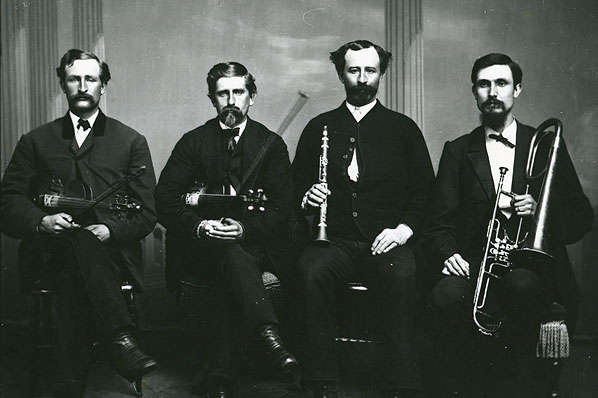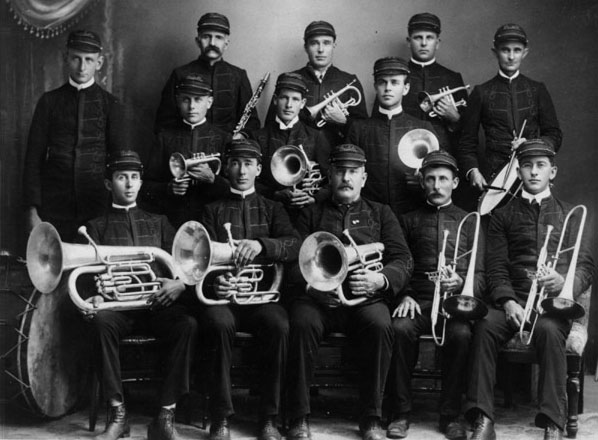A characteristic feature of the music life with ser. 19th century there was a “minstrel theater” or “minstrel show” (also called “Ethiopian groups”); actors and musicians – participants in these performances dressed up as blacks, performed in exotic. costumes, accompanied their performance with dances, comic. facial expressions and eccentric numbers, parodying the Negro. musical style. A similar tradition, which originated in England in the 18th century, was introduced into the Amer. claim in English actor C. Matthews, who came to the USA in 1822. The significance of the minstrel show was determined by the fact that these performances drew the attention of the general public to the music of Amer. blacks (despite the fact that many numbers were offensive to them). Especially popular was the character “Jim Crow” – a “negro simpleton”, who embodied “common sense”.

He mocked the mannerisms of salon music, admiration for the Italian. opera, etc. The first “stars” of this genre were the artists J. W. Dixon, T. D. “Jim Crow” Rice and others. 1840s Christie’s Minstrels, Bryant’s Minstrels, Virginia Minstrels performed in New York and Boston. The latter was led by “Old Man” D. Emmett, the author of the popular songs “Old Man Dan Tekker”, “Dixie” and others.
The songs of this genre, distinguished by their simplicity, intelligibility of melody and text, were easily remembered; they were usually sung in accompaniment. violins, banjo, castanets.
The best of the bands often toured Europe. By the 1860s it was ok. 30 permanent groups, as well as temporary, recruited for seasonal tours around the country. Increasingly, Negroes performed in them, exaggeratedly making up “under the Negroes.” The lyrical-comedy traditions of the minstrel show had a meaning. impact on b. hours of subsequent forms of Amer. music t-ra and stages. By the 1870s Minstrel shows began to be supplanted by vaudeville, burlesques, which had become popular by that time, “veraity shows” (performances that combined songs and dances with acrobatic numbers), etc., which were distinguished by dynamism of action, rude humor, designed for unpretentious tastes. Minstrel show is still for several. decades remained popular in small towns, remote from cultural centers.
The creativity of S. Foster, sentimental, patriotic, is closely connected with the traditions of minstrel tr. and k-mich. songs to-rogo gained immense popularity in the United States (many of them were perceived as folk songs); such songs as “Oh, Suzanne”, “Kampton Leaps”, etc., had a great influence on later songwriting in the United States.
All R. 19th century the tradition of the “floating t-ra”, associated with the rapid development of shipping on the Mississippi, became widespread. The troupe made a trip along the river on a ship with a stage built on it and gave a performance at each pier. The spirit also became popular. orchestras (bands), to-rye were created at first at army units, police stations, fire brigades, etc.; they existed even in small towns and often performed in dec. festivities, societies. ceremonies, etc.
The earliest known ensembles are the Massachusetts Band (founded in 1783) and the Band of the United States Navy (founded in 1798);
The brass band of New York (founded in 1834, leader T. Dodworth) won popularity with the performance of marches, dances, and hymns. The spread of bands and music for bands was facilitated by patriotic. sentiments evoked by the Civil War of 1861-65 and expressed in the popular songs of J. F. Root and H. C. Wark. The evolution of the band from a marching ensemble to a concert, and then the modern. symp. the band was reflected in the work of famous band leaders P. S. Gilmore, W. Herbert and J. F. Sousa (“the king of the marches”, toured in many countries), then E. F. and R. F. Goldman (now in USA several tens of thousands of bands). The skill grew, the technique became more complicated, the composition increased; became more developed and varied in the nature of compositions for the band.

This was facilitated by the release of muses. high-quality instruments by Selmer, Worlitzer, Conn, W. Bach, Grech, etc. (a rich collection of musical instruments – from ancient to modern – is stored at the Smithsonian Institute in Washington). After the end of the Civil War, the music was developed. education; a prominent role in this belongs to the composer, organist, and teacher L. Mason (as early as 1832 he founded the Boston Academy of Music and in 1854 the New York Institute of Music), who developed the most important principles of music. pedagogy (he was a follower of I. G. Pestalozzi). Muses arose. uch. establishments in various cities: Academy of Music in Philadelphia (1857), Oberlin Conservatory (Ohio, 1865), Conservatory in Cincinnati, New England Conservatory in Boston, Chicago Music. college (all – in 1867), Mus. in-t Peabody in Baltimore (1868, sponsored by patron J. Peabody), etc. The study of music was included in university programs; if in con. 19th century un-you prepared ch. arr. music historians, then later they began to teach music-theoretical. objects, composition, game for various purposes. instruments, etc. In 1875, the main. first music. college at Harvard University (colleges in the USA roughly correspond to faculties in Soviet universities), then to Pennsylvaniaskom (Philadelphia), Yale (New Haven) and others. the Music Teachers Association (MTNA, since 1876) and the National. music conference. enlighteners (MENC, from 1907). More and more clearly manifested a tendency to educate their own. music personnel in the music. US institutions; from the 2nd floor. 19th century Amer. musicians began to study in the USA and traveled to Europe (mainly to France and Germany) to complete their studies and improve their skills.
Philanthropy acquired a wide scope – individual wealthy Americans or entire groups of individuals financed orchestras, music and education. establishments, did creative. orders to composers, subsidized the construction of opera houses, as well as conc. halls – in Cincinnati (1878), Chicago (1889), New York (“Carnegie Hall”, 1891; based on the funds of the multimillionaire E. Carnegie), Boston (1900), etc.
